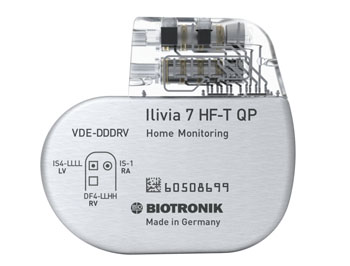Innovative ICDs Automatically Adapt to MRI Settings
By MedImaging International staff writers
Posted on 17 Feb 2016
A new line of implantable cardioverter defibrillators (ICDs) and cardiac resynchronization devices (CRT-Ds) can automatically detect MRI environments.Posted on 17 Feb 2016
The Biotronik Ilivia ICDs and CRT-Ds feature both ProMRI, a technology that allows patients with a cardiac system to safely access MRI scanning, and MRI AutoDetect, which allows the cardiologist to activate a time window lasting up to 14 days, during which all device functionality is maintained until the patient undergoes the actual scan; at that point the device automatically switches into MRI mode. Once the scan is completed, all device functionality is once again restored automatically, all without the need for the cardiologist’s intervention.

Image: The Biotronik Ilivia 7 HF-T QP CRT-D with MRI AutoDetect (Photo courtesy of Biotronik).
Soon after the scan, the cardiologist receives a full report via Biotronik Home Monitoring, a system designed to replace device interrogation with customizable fully programmable alerts, with options to specify alert thresholds and ranges, and call-back notifications that direct the patient to contact the clinic. Other features include MultiPole Pacing (MPP) to improve therapy for CRT patients, a closed loop stimulation (CLS) algorithm for more adaptive pacing, and DX technology for ICDs and CRT-Ds. Biotronik Ilivia ICDs and CRT-Ds are products of Biotronik (Berlin, Germany).
“MRI AutoDetect will not only reduce the amount of time the patient’s device stays in MRI mode, but I expect it will also greatly improve the workflow between the cardiologist and radiologist, which will ultimately benefit our patients,” said Manuel Ortega, senior vice president of Biotronik. “MRI AutoDetect is the next step in ensuring that patients get the full benefit of both their implanted devices and diagnostic imaging.”
“Patients aren’t fully protected if they have an event while their devices are programmed in MRI mode, a period that currently can last a day or more depending on hospital workflows,” said Richard Kobza, MD, head of cardiology at Luzerner Kantonsspital (Lucerne, Switzerland). “Reducing the amount of time a device is in MRI mode is particularly crucial for ICD and CRT-D patients, and with MRI AutoDetect the only time these patients won’t be able to benefit from full device therapy is the short 30-minute window they spend in the MRI machine itself.”
At present, when a cardiac device patient needs to undergo a MRI scan, a cardiologist must program his or her device into a special mode that temporarily reduces the device’s functionality until the MRI scan is completed. Following the scan, the cardiologist must switch off the device’s MRI mode to allow the patient to once again have the full therapeutic benefits of their implanted device.
Related Links:
Biotronik














